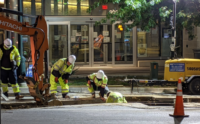Five development teams will vie for the opportunity to help the Los Angeles Metropolitan Transit Authority build a heavy-rail public transit corridor through Sepulveda Pass in the rugged Santa Monica Mountains, creating a high-capacity, high-speed connection between the city’s west side and the San Fernando Valley.
Projected to cost nearly $14 billion, the new transit line is envisioned to relieve crowding on the I-405 freeway, one of the nation’s busiest and frequently congested freeway corridors, with daily traffic volume regularly surpassing 400,000 vehicles a day.
Announced by Metro in mid-January, the shortlisted team leaders and key industry partners include:
• ACS Infrastructure Development, Inc., with Dragados USA and Stantec
• Bechtel
• BYD Transit Solutions, with HDR Engineering, Skanska USA Civil and Gensler
• Fengate, with Lane Construction
• Tutor Perini, Parsons and Plenary Group USA
Each team will now submit a Predevelopment Agreement (PDA) proposal to assist with planning and design of the project, which currently calls for the 15-mile initial phase between Van Nuys and West Los Angeles to begin operations in 2033 with up to eight stations and connections to existing Metro transit lines. A 9-mile second phase, currently set to open in 2057, would extend the transit line to Los Angeles International Airport. A local transportation sales tax measure passed in 2016 will provide up to $9.5 billion in funding for both phases.
Later this summer, Metro plans to select up to two PDA partners to refine the project’s design, construction, financing and operational approaches, taking advantage of early contractor involvement, according to the agency. One or both PDA partners could ultimately oversee project development, and be given the opportunity to build, operate and maintain the line, potentially accelerating construction, improving project performance and mitigating key project challenges, according to the agency.
Metro spokesperson Dave Sotero adds that options may be drawn from above- and below-ground heavy-rail and monorail concepts developed over the past few years, or ideas brought forward by the PDA partners.
“We may also choose to go in a different direction,” Sotero says. “We’re giving ourselves as much flexibility as possible.”
That could include fast-tracking the project’s schedule to have least part of the system operational for the 2028 Summer Olympic and Paralympic Games.
“This an opportunity to find an innovative partner with expertise that might help us accelerate the schedule,” Sotero says.






Post a comment to this article
Report Abusive Comment